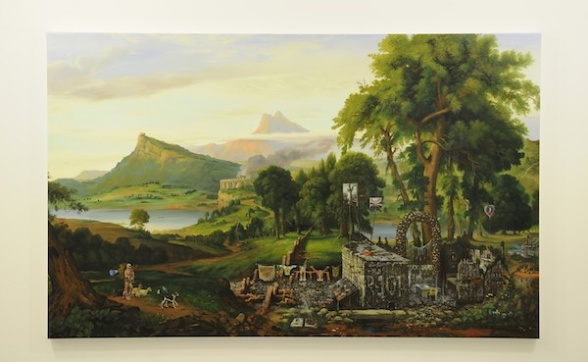Ged Quinn
Ged Quinn, Places In The World to Hide, 2008. Photograph by Adatabase
The paintings of Ged Quinn (b. 1963 Liverpool) are at once real and fallacious. Landscapes by romantic masters including Claude Lorraine and Casper David Friedrich are reworked, typically on oversized canvases, translating Arcadian visions to ambiguous place with latent narratives. From this variegated metaphorical fabric, Quinn develops and displays an irreverent array of Western cultural references. Temporal logic is negated, and the course material distorted beyond rational interpretation - if, that is the Sublime may ever be rational
For MADE UP, Quinn's piece entitled Places in the World to Hide (2008), a painting from one of Thomas Cole’s vast allegorical cycles The Course of Empire (1836), became the setting for a dilapidated shanty town. At its entrance stood a decorative gate to a heaven more funeral parlour than Romantic Elysium. Blood-stained clothes and a Sudarium hung on a line above further ramshackle evidence of the dwelling’s unknown, unseen inhabitants. From the left approached a traveller carrying a magic lantern and wearing a makeshift gas mask to protect against the arena of disaster on whose threshold he stands. Swastika-branded sheep at his feet further mythologised this strange explorer, a wandering soul discovering, returning, or perhaps already departed.
The references embedded within Quinn's canvases should collide and destroy each other. Yet somehow, through the weird familiarity of their sources, they edge towards resolution of a kind. This is not to say the narratives that start and stop, confined to the space of the painting, find an ordered development or progression; but the figures and references that squat within his works do seem meant to be there. Quinn conceives of his appropriated, re-imaginings of the locations from art history as real places and real states. The Arcadian nostalgia of Claude or the turbulent Nature-versus-life metaphors of Ruisdael become counter-weights to Quinn's contemporary preoccupations. The result is an uneasy, haunting balance that disturbs and lingers like an unfinished dream.
Ged Quinn at Liverpool Biennial 2008
Places In The World to Hide, 2008
Oil on linen
Commissioned by Liverpool Biennial 2008
Exhibited at Tate Liverpool
Supported by
Calouste Gulbenkian Foundation
Liverpool Biennial
55 New Bird Street
Liverpool L1 0BW
- T +44 (0)151 709 7444
- info@biennial.com
Liverpool Biennial is funded by
Founding Supporter
James Moores
